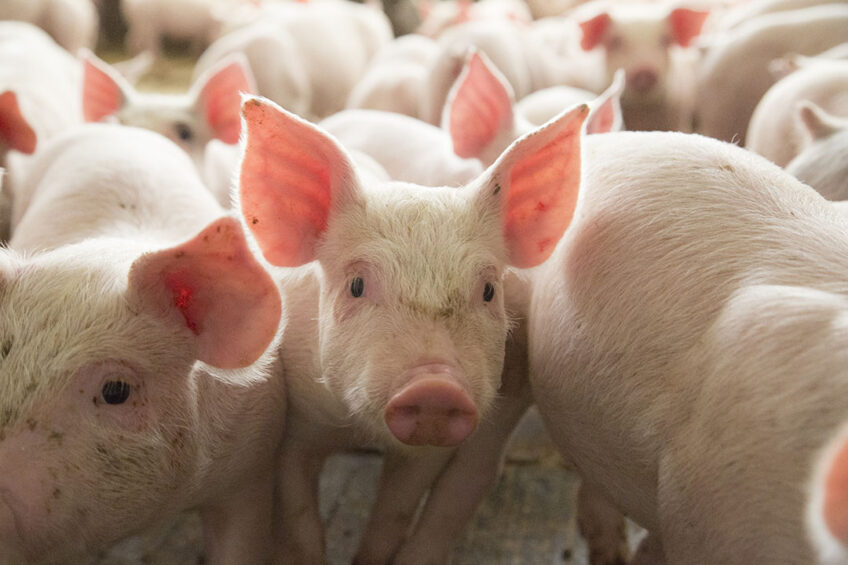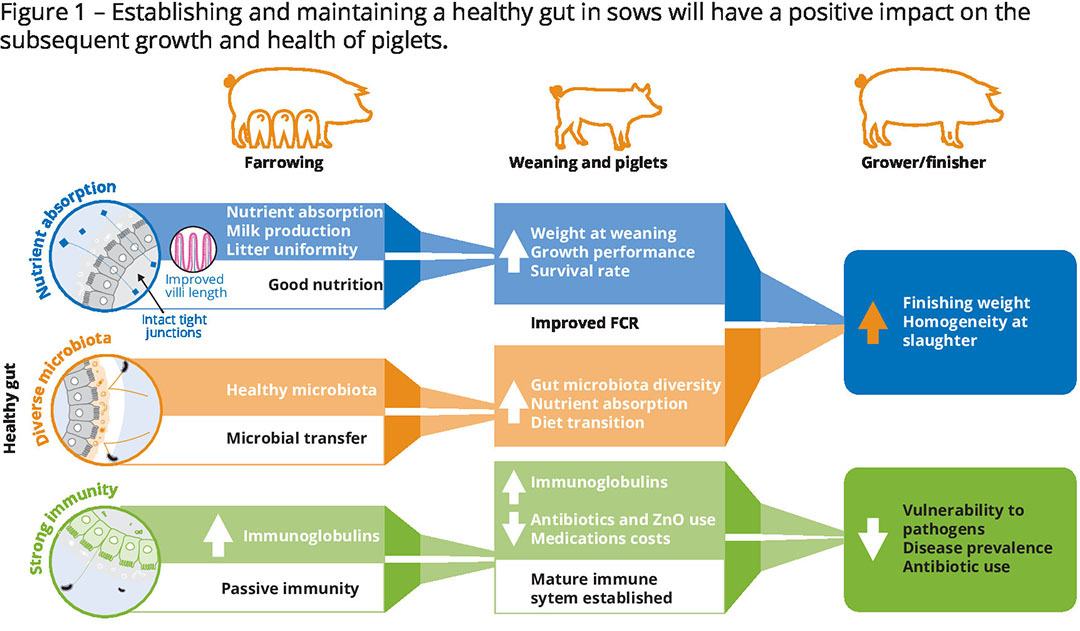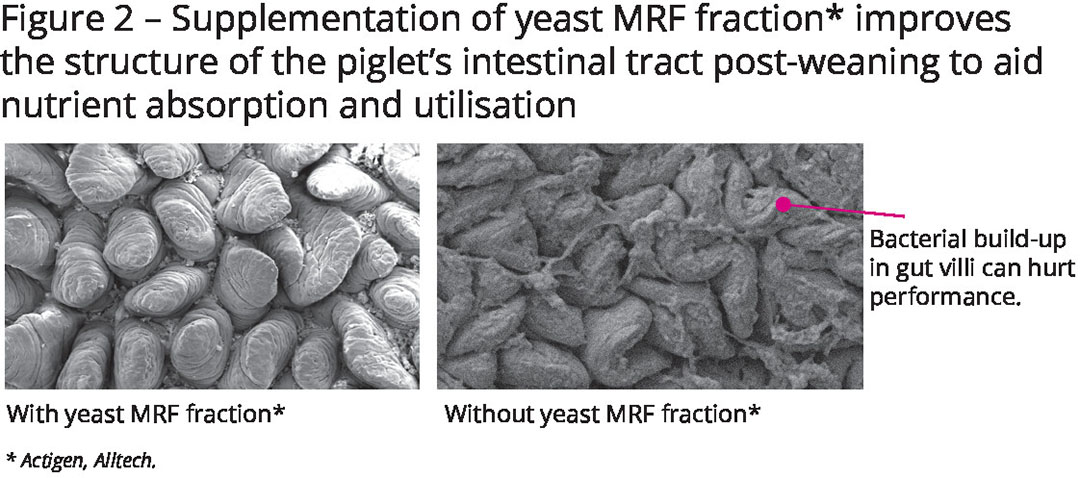Embracing the power of a healthy gut

Reducing pathogen loads in swine production can be achieved by adopting an approach that considers the health both of sows as well as of their piglets. That way, harmful bacteria like Escherichia coli or Salmonella species have a hard time of becoming successful.
According to a recent report published by the United Nations, the world population is expected to increase by a further 2 billion in the next 30 years, reaching a staggering 9.7 billion people by 2050. This continued growth is naturally coupled with increased demand for animal-based protein, and pig meat is expected to remain one of the core sources of animal protein consumed worldwide.
The emergence of pathogens
Over the past several decades, the growing demand for pig meat has resulted in intensification of the global swine industry, which has seen a shift from traditional small-scale pig units to large-scale operations. These industrialised pig units typically accommodate thousands of animals in environments ideal for spreading pathogens, despite best practices for optimal pig health and welfare being in place. Bacterial and viral pathogens significantly impact commercial pig production through losses in performance, poor health and increased mortality, with great economic consequences.
Diverse microflora for a healthy gut
However, pathogen prevention is important not only for animal welfare and productivity but also for food safety and public health, as pig meat is a source of foodborne diseases. A key part of the solution for producing healthy and safe pigs includes achieving a stable gastrointestinal tract and a diverse gut microflora – both of which will help producers reduce the prevalence of intestinal pathogens without increased use of antibiotics.
Important pathogens in pig production
Intestinal diseases are a major source of production and economic losses for the swine sector, and neonatal diarrhoea and post-weaning diarrhoea are regarded as 2 of the most observed intestinal disorders in modern pig production. Enteric outbreaks of these diseases are often multifactorial and commonly linked to the presence of a wide range of bacterial, viral or coccidian pathogens. E. coli and Salmonella species are the most frequently detected bacterial pathogens associated with targeting and damaging the gut and causing diarrhoea disorders in pre- and post-weaned piglets.
E.coli
E. coli is a gram-negative, rod-shaped pathogen that threatens not only pig production but also food safety, given that most strains of E. coli are considered zoonotic. This bacterium typically affects piglets when their immune system is most vulnerable. In newborn piglets, E. coli is transferred to the offspring via the sow faeces and birth canal, resulting in severe dehydration and, subsequently, high mortality rates. Although the effects of E. coli are less severe after weaning, the presence of E. coli still results in intestinal disorders and reduced growth performance. To give piglets the best start in life, producers should focus on maximising colostrum quality to boost the passive immunity gained from colostrum intake and support piglet gut health as soon as possible after birth.
Salmonella species
Like E. coli, Salmonella species are gram-negative enteric pathogens of zoonotic concern, widely affecting food safety. Salmonella is a global pig production issue, with recent reports stating that it is responsible for roughly 91,000 foodborne illnesses in Europe and 1 million in the US each year. The 2 most important serotypes isolated in pigs are S. Typhimurium and S. Choleraesuis, both of which cause diarrhoea in young pigs.
Healthy gut, healthy herd
A key component of reducing the pathogen load and, subsequently, producing safe pork products is to adopt an integrated approach that considers maternal gut health and development as well as that of the offspring.

The sow can often be overlooked when implementing pathogen control strategies. However, the microbial composition of a piglet’s intestine in early life closely resembles that of the sow’s (faecal and vaginal), demonstrating that the first colonisers of the piglet’s intestine are derived from the birth canal. As such, establishing and maintaining a healthy gut and stable microbial population in sows will lead to the maternal transfer of indigenous beneficial microbes to the developing foetuses and the suckling piglets through maternal colostrum and milk (Figure 1).
MRF from Alltech
Certain feed materials can help maintain a healthy gut by reducing the load of pathogenic bacteria and promoting gut microbial diversity, all of which will allow animals to respond more effectively to pathogenic challenges. Multiple research studies demonstrate that feeding Actigen, Alltech’s proprietary yeast mannan-rich fraction (MRF) derived from Saccharomyces cerevisiae, can help to reduce gut colonisation due to the product’s ability to bind pathogens and support the health and lifetime growth performance of sows and their offspring.
Recent data demonstrated that MRF supplementation can significantly reduce the attachment and adhesion of E. coli and Salmonella Dublin to porcine intestinal cells. Preventing these bacterial pathogens from attaching to and colonising the gut can directly affect lowering inflammatory markers for infection, making MRF an essential part of the strategies to reduce foodborne diseases.
MRF in the maternal diet
Studies focusing on sow gut health have also shown that incorporating MRF into the maternal diet can increase the immunoglobulin content in colostrum, therefore improving the piglet’s passive immunity and helping to provide protection from disease challenges in early life. As mentioned above, an important determinant of the health and performance of piglets is microbial colonisation and gut development after birth.

Supporting a healthy gut
The MRF product is designed to modify the gut microbial population, establish more diverse and favourable microbial populations and support optimal gut health. Several studies have demonstrated a significant improvement in the intestinal structure of piglets after weaning via the MRF supplementation in piglet diets. Nutrient absorption and utilisation increased, followed by an improvement in piglet weight gain and feed conversion efficiency.
Making swine heards more resilient to pathogen challenges
As the gut is the first line of defence against many diseases, supporting a healthy and diverse gut microbiome will help to make swine herds more resilient to pathogen challenges and, in so doing, increase food safety and reduce antibiotic usage. Applying an integrated approach from sow to offspring that incorporates feed strategies such as Actigen may be one solution to control pathogens and help pig producers achieve optimal health, performance and profitability goals.
* References available from the author upon request







